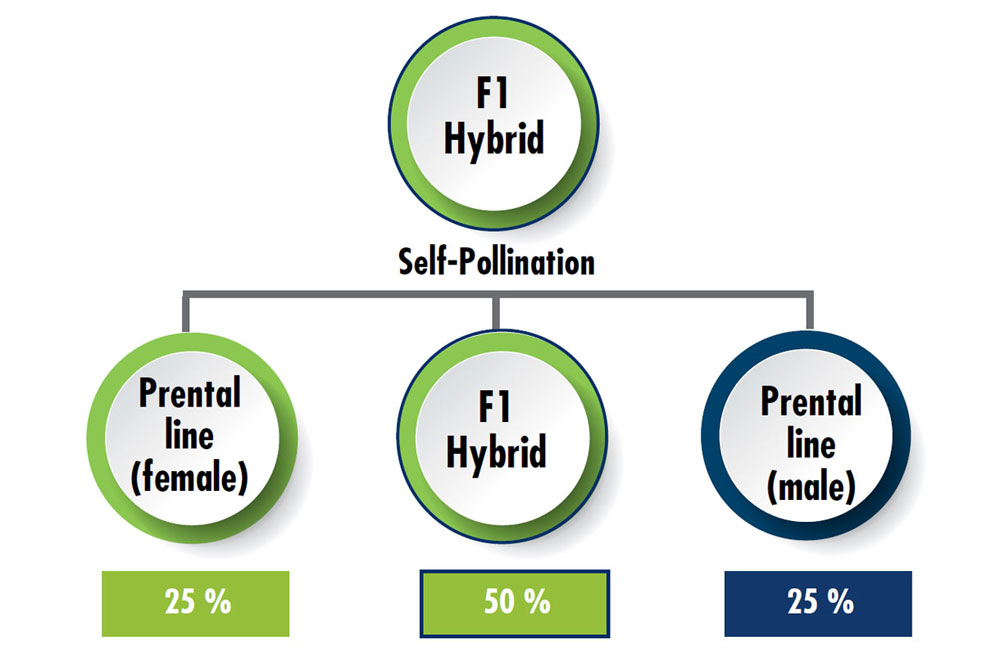Seed Production and Seed Quality
Seed production know-how is crucial to successful commercial development of hybrids. Hybrid wheat seeds are not just „seeds“. They are high tech products. Following the harvest the seeds are tested in certified seed quality labs. Only the best seed lots are chosen. Finally, the seeds are sorted, treated and bagged at the seed processing plant, ready to be sown. Year by year we are increasing our knowledge and optimising our seed processing chains to provide the best quality hybrid wheat seed to our customers all over Europe.
Both breeding and seed production of hybrid varieties is significantly more complex in comparison with conventional varieties. For that reason, seed processing is only carried out by well experienced multipliers and selected production companies in France. In addition, the seed production fields are monitored by production engineers of ASUR throughout the whole season. To avoid seed losses, seed production fields are spread all over France. Our partners are using an innovative storage technology TAMIA PACK® which facilitates stock management and prevents losses in seed quality. These factors guarantee a high level of seed quality and ensure seed availability to the farmers.
As hybrid seed is produced by crosspollinated plants it has to be produced anew every year. Seed production is split in 2 major part:
1. Parental line seed production
Each hybrid wheat variety consists of 2 hereditary components, 1 female and 1 male, which need to be maintained. In case of hybrid wheat, which is produced with HA (Chemical Hybridizing Agent) technology both parental components the female line (seed parent) as well as the male line (pollen parent) are fertile. No maintainer needed.
2. Certified F1 hybrid seed production
Certified F1 hybrid seed is produced by crossing a male sterile female line (no pollen production) with the fertile male parent (pollen production).
Unique Production Technique
Wheat is naturally self-pollinating and fertilisation takes place in a self-contained environment made up of husks enclosing the pistils and stamens. In order to enable a large-scale seed production, ASUR Plant breeding has established a unique seed production system based on the hybridisation technique with the hybridisation Agent (CROISOR® Pack). This substance prevents pollen production causing male-sterile wheat plants: the female line.
The male parent and the female parent are sown in alternating strips between three to eight metres wide in the seed grower’s field. The female parent is treated with HA at an early growth stage. The size of the ear is an important characteristic for an optimal timing of the HA application.
After the successful HA application, the female parent is fertilised from pollen produced by the untreated male strips. The hybrid seed is the grain which is harvested from these female strips. SAATEN-UNION produces all of its hybrid wheat seed using the hybridisation agent CROISOR® Pack.
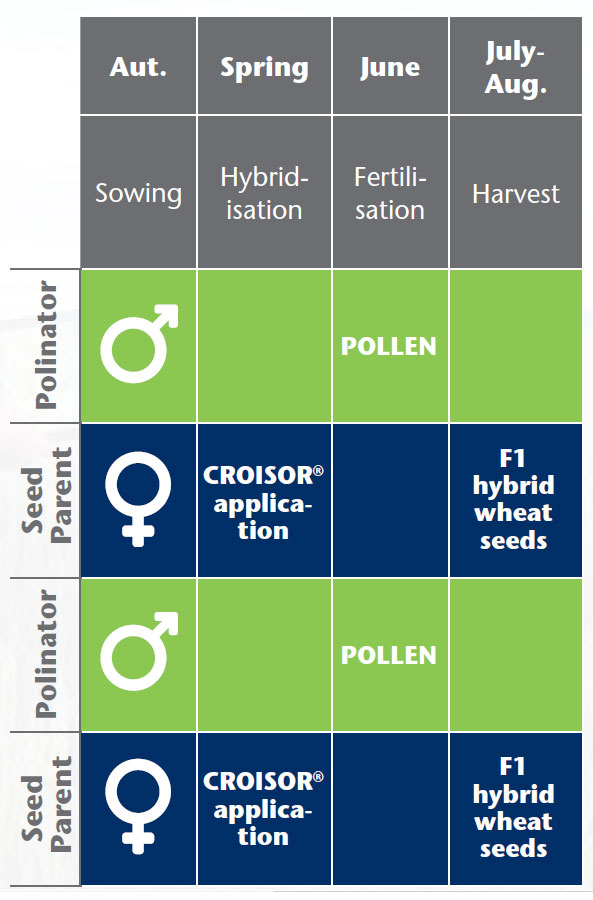
Quality control in the field
To ensure that the grain-bearing plants have been properly sterilised and therefore the grain really derives from cross-fertilisation by the pollinator, isolation cages are placed in the female strips after treatment and before flowering. The cages are removed shortly before harvesting and the ears under the cages are controlled for any presence of grains (a sign of self-fertilisation): the ears must be free of grains (5 % tolerance, a threshold regarded necessary to ensure a minimum of 95 % hybrid grains, which is the marketing standard). Otherwise, the production is refused and sold as feed wheat. If in doubt, the genetic identity is checked by electrophoresis on a sample of harvested grains.
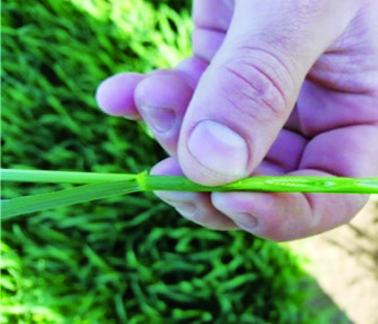
Seed Quality
In order to ensure our customers high yields SAATEN-UNION places great emphasis on seed quality testing. Therefore, hybrid wheat seed has to pass numerous laboratory tests before it goes on sale.
1. Germination rate
Germination rate describes the percentage of seed that produce a normal seedling under regulated laboratory conditions. SAATEN-UNION hybrid wheat seed is tested according to the official seed testing rules. All commercial hybrid wheat lots should have a minimum germination rate of 92 %. Due to the great experience and high standards of our partners in regard to seed production, germination rates of 95 % and higher are achievable.
2. Hybridisation rate
Hybridisation rate shows the percentage of hybrid seed from the total harvested seed.
F1 seed is produced by using basic seed of the female and male parental lines. The female seed donor line is treated with HA. After the treatment it becomes 100 % sterile. Sterility is tested in the field by using so called pollen cages. Finally, hybrid seed is the grain which is harvested from the female parent after cross pollination. The hybridisation rate of hybrid wheat is regulated by the EU law. The standard level is 95 %. The hybridity rate in the field is evaluated according to the number of seeds formed on ears covered with pollen-proof bags.
ASUR double checks all seed lots with electrophoresis tests to ensure a hybridity rate between 95 % and 98 %. An alternative field hybridity control method using marker analysis on DNA extracted from immature seed has been developed by ASUR. It gives more accurate and faster results and avoids the tedious and time-consuming system of working with pollen bags. It has currently being tested by the French Certification Agency in terms of a possible approval and substitution by 2021.
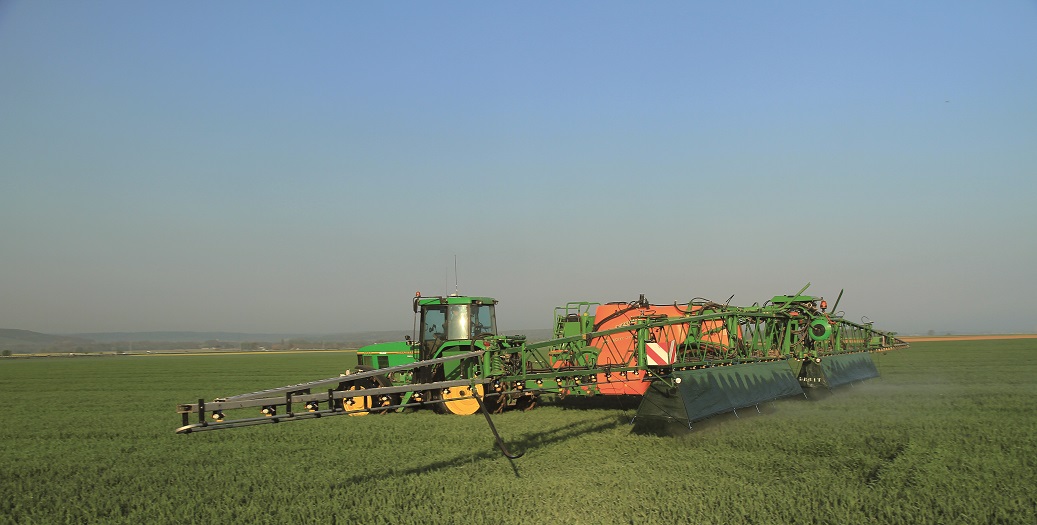
3. Seed purity
Seed of hybrid wheat has to be homogeneous and free from inert matter, other crop and weed seed. Hybrid wheat seed is cleaned by using several different sorters, including an optical sorter, achieving high purity rates (>98 %).
4. Seed treatment Two different standard seed treatments
Vibrance Gold – Fungicide containing sedaxane 50 g/l (pyrazole/SDHI), fludioxonil 25 g/l, difenoconazole 25 g/l (triazole), effective against seed and soil-borne pathogens like Fusarium species and Rhizoctonia species, improves crop establishment.
Disease risks can be reduced with this seed treatment if second cereals are cultivated.
Langis – Insecticide containing cypermethrin 300 g/l (pyrethres), protection of cereals, which had maize or grassland as a preceding crop, against wheat bulb fly and wireworms that cause feeding damages on seedlings and tillers.
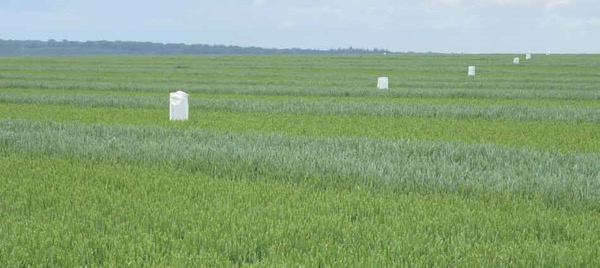
Additional seed treatment Silver Coating
Due to the high genetic value of hybrid wheat and hybrid barley the level of seed processing has to be improved. The coating agent Silver-Coat®, a microporous film applied to the surface of the seed, improves coverage and uniformity of the seed treatment as well as grain flow in the drill.
The bright, silver colour of Silver-Coat® has also the additional advantage to make it easier to track seeds in the drill furrow. Dosing and choice of coating products are regularly reviewed in order to optimise seed coverage and to limit the risk of dust emissions as much as possible. Untreated seeds can also be delivered.
5. GrainForce
GrainForce is our new biostimulant and micronutrient seed treatment that has been developed by the german innovative start-up SeedForward. With steadily increasing restrictions in plant protection, high plant vitality and stress resistance is of increasing importance to realize high yields. With GrainForce, we offer a new possibility to keep plants vital and strengthen them against all kinds of stress.
Besides micronutrients, GrainForce consists of a broad variety of microorganisms which support plant growth (above & below ground), improve stress tolerance against biotic and abiotic stress and increase nutrient uptake. These microorganisms produce enzymes that unlock & mobilize additional nutrients, colonize the root surface as competitors to soil-borne pathogens, produce growth-enhancing substances, and strengthen the plant resistance.
Next to the standard chemical treatment, the Saaten-Union offers a combination of GrainForce plus the standard chemical treatment for your seeds.
6. Bagging types
We can propose different kind of bagging. Usually in hybrid wheat we are dealing with units of 500.000 seedsthe standard bags. Furthermore, we also offer big bags with 12 million seeds
Innovative storage technology at ASUR Plant Breeding
TAMIA PACK technology is a newly created subsidiary of ASUR PB. TAMIA PACK offers the SAFET’HY industrial process for all seeds including hybrid and non-hybrid cereals. At ASUR all seed stocks are now stored using this process.
SAFET’HY® industrial process for vacuum preservation of seed and grain:
- Controlled storage: preserving quality. Germination level remains on a high level.
- Securing stocks without insecticide treatments: After 5 years of use performance has been proven on more than 6,500 tons.
Advantages for farmers: High level of seed quality in regard to germination rate and low risk of contamination by insects.
Advantages of Using Certified F1 Seed.
According to European law it is forbidden to sell or to grow farm saved seed of hybrid wheat. Furthermore, reproduction of hybrid wheat seed results in heterogenous fields as well as severe yield reductions.
A conventional variety is selected from a cross over eight to ten generations, with pollination taking place via the natural mechanism of self-pollination. Throughout the process „countless“ genetically different strains segregate from one cross of which only the „best“ is developed into a variety. Thus, a conventional variety is based on genetic „equality“, which means if reproduced largely identical offspring with hardly any changes in performance characteristics are produced.
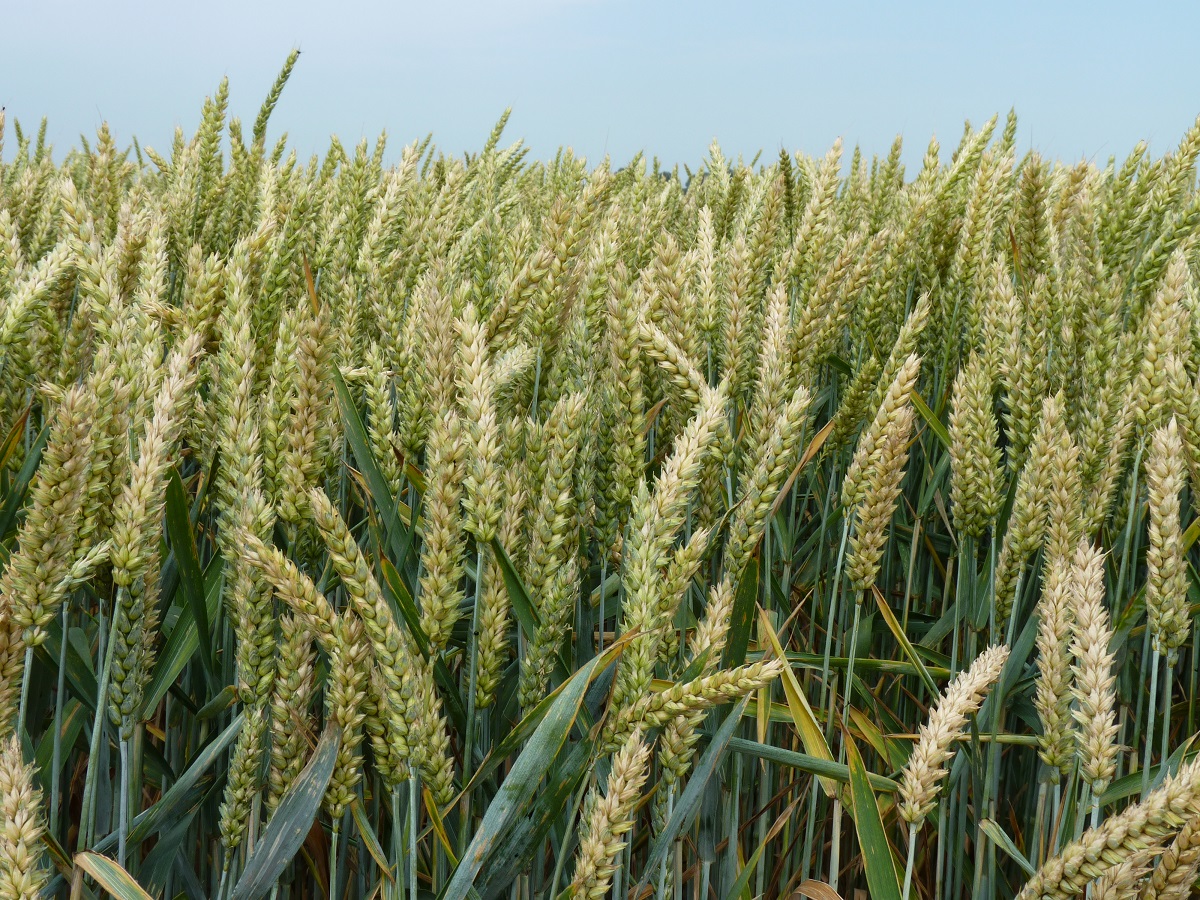
On the other hand, the hybrid variety is only a recently created cross (AxB). It is a combination of two different parental lines. In this state the so-called heterosis effect is expected.
Heterosis of a cross is defined as superior performance surpassing the average of its parents. According to the law of segregation (Mendel’s laws of inheritance) hybrid reproduction/self-pollination inevitably leads to a genotypic segregation ratio of 1:2:1. The heterosis effect is lost, performance decreases.
Certified F1 Seed has following advantages:
- Newest genetics with 100 % heterosis effect
- High level of hybridization (min. 95 %)
- High level of purity
- High quality seed treatment
- Less workload
Segregation of F1 Hybrid Wheat
